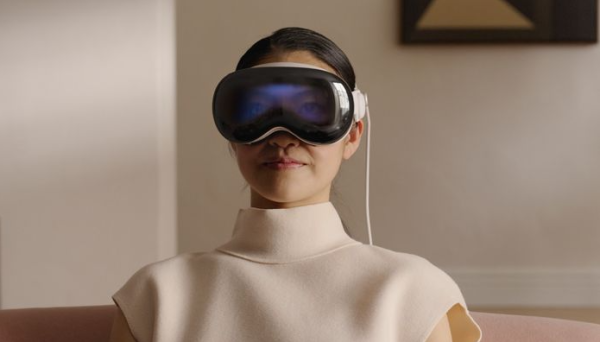Apple Vision Pro Headset Details: Specs, Release Date, Price, and More
Apple’s long-rumored mixed reality headset which has been under development for close to a decade, the Apple Vision Pro, was finally announced this week.
During the company’s keynote at the WWDC early this week, Apple unveiled its AR/VR headset, the Apple Vision Pro. Apple avoided using the usual terms such as Virtual, Augmented, or Mixed Reality to describe its device. Instead, the company emphasized Spatial Computing or Spatial Computer.

The Apple Vision Pro
The Apple Vision Pro is Apple’s XR headset. In its presentation, Apple did not delve into the headset’s hardware specs although some of the earlier leaks about the device proved accurate.
The Vision Pro headset has two micro-OLED displays and a resolution of more than 4K per eye which provides 23 million pixels to the screen ( 3.3 times the pixel density of the Quest 2 headset).
The headset reportedly delivers very sharp images, in combination with its special catadioptric lenses. It also supports HDR. It is not yet apparent what the device’s field of view will be. It has a default frame rate of 90Hz although most 24 FPS movies use the 96Hz mode.
The headset also has a “reverse-passthrough” display on the front part that reproduces the user’s eyes, a feature that has been subject to various internet memes. This mode looked like wearing tinted diving goggles in the presentation. This reverse passthrough display is meant to create more natural social interactions when using the headset in augmented reality mode.
It is powered by Apple’s M2 processor which will handle its main computing load.
It also features a second custom-designed chip known as R1 which offers a “near-instantaneous” real-time viewing of the actual environment.
The headset runs on the new VisionOS operating system that has been developed for spatial computing uses and also supports Unity and ARKit.
Passthrough, Hand and Eye Tracking
The headset features two color-passthrough mode cameras for see-through into the surrounding real-world environment.
It also has eight other cameras including infrared and two cameras that point downwards and deliver precise hand tracking, thereby removing the need for virtual reality controllers.
It has a LiDAR sensor along with two depth sensors that offer real-time 3D mapping of the real-world environment.
The Apple Vision Pro headset can also function as a 3D camera, for capturing 3D images and videos with the mere press of a button.
Apple is also planning to introduce spatial Facetime Calls that will leverage the sensors in the XR glasses.
The Vision Pro headset uses eye tracking that is based on multiple infrared LEDs and four high-speed cameras. This allows for foveated rendering functionality where the images the eyes are focusing on will be rendered in full detail with the rest of the images in the peripheral vision being blurred out to minimize rendering workload and optimize computing power.
The Vision Pro headset is activated through an iris scan. Its interpupillary distance is adjustable, mechanically.
Battery, Spatial Sound, and Operation
The headset’s battery connects to it using a cable and is wearable on the hip or in the pocket. The battery lasts two hours. Apple did not indicate whether it is hot-swappable.
The Vision Pro headset is controlled via a combination of eye tracking and hand tracking. There is even voice control. These controls look precise and intuitive in the Apple presentation. The headset will not have virtual reality controllers.
The headset features spatial audio speakers that have been integrated into the headband. These speakers will supposedly include the environment through audio ray tracing.
Design, Comfort, and Modularity
The Apple VR/AR headset resembles slim ski goggles. The headband acts as a mount and features a wide and stretchy strap that has been designed to provide comfortable support to the back of the head. You can even wear Vision Pro comfortably while lying down, unlike other VR/AR headsets.
The headband may not be suited for sports and fitness experiences. However, Apple did not showcase any sports-related functionalities during the presentation.
The face mask is made using a fabric which according to Apple, was designed from thousands of facial studies and can adapt to individual face shapes. The face mask is also available in various shapes and sizes.
The headset has a modular and interchangeable face pad and headband. You can’t fit regular glasses under the Vision Pro headset but users with eye problems can, instead, magnetically attach prescription lenses from Zeiss.
Target Market, Games, and Entertainment
Unlike Meta’s Quest Pro, the Apple Vision Pro isn’t targeting professionals as widely expected. Apple will be marketing the headset as a VR/AR headset for daily home use and a companion for use on the go as well as a work device.
Apple hasn’t announced any virtual reality games for the headset yet. Apple will also be partnering with Disney for immersive entertainment content for the headset.
https://virtualrealitytimes.com/2023/06/09/apple-vision-pro-headset-details-specs-release-date-price-and-more/AppleBusinessApple’s long-rumored mixed reality headset which has been under development for close to a decade, the Apple Vision Pro, was finally announced this week. During the company’s keynote at the WWDC early this week, Apple unveiled its AR/VR headset, the Apple Vision Pro. Apple avoided using the usual terms such...Rob GrantRob Grant[email protected]AuthorVirtual Reality Times - Metaverse & VR
